

CE 2015031710033222. Stop Teaching Students What to Think. Teach Them How to Think. Commentary —Getty By Scott Santens For more than a century, we've been creating an industrial workforce of human automatons, built for the purpose of performing routine labor not yet doable by machines.

And we've been operating with the mindset that we should teach students the same way we program actual machines. In the 20th century, schooling became a process of information upload in which students are to be filled with all the appropriate data and applications to function as cogs in the machinery of factories and offices, or in the parlance of today, as walking hard drives. Modern mass production did more than increase efficiency. Human-automaton creation must end. 48 Critical Thinking Questions For Any Content Area - 48 Critical Thinking Questions For Any Content Area by Ashley McCann Critical thinking is the heart and soul of learning, and–in our estimation anyway–ultimately more important to than any one specific content area or subject matter.
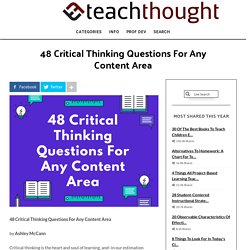
It’s also an over-used and rather nebulous phrase — how do you teach someone to think? Of course that’s the purpose of education, but how do you effectively optimize that concept into lasting knowledge and the ability to apply it broadly? Creatical Thinking. 10 good Apps to Enhance Kids Critical Thinking Skills. July 31, 2017 Critical thinking is a key skill in today's learning.

10 Team-Building Games That Promote Collaborative Critical Thinking. 10 Team-Building Games That Promote Critical Thinking by TeachThought Staff.
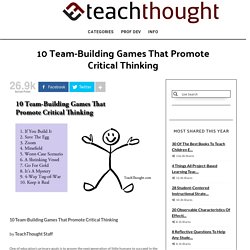
28 Critical Thinking Question Stems For Any Content Area - 28 Critical Thinking Question Stems For Any Content Area.
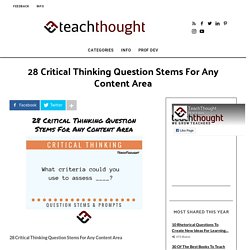
Study: There Are Instructions for Teaching Critical Thinking. Whether or not you can teach something as subjective as critical thinking has been up for debate, but a fascinating new study shows that it’s actually quite possible.
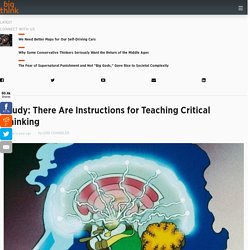
Experiments performed by Stanford's Department of Physics and Graduate School of Education demonstrate that students can be instructed to think more critically. It’s difficult to overstate the importance of critical-thinking skills in modern society. The ability to decipher information and interpret it, offering creative solutions, is in direct relation to our intellect.
The study took two groups of students in an introductory physics laboratory course, with one group (known as the experimental group) given the instruction to use quantitative comparisons between datasets and the other group given no instruction (the control group). Comparing data in a scientific manner; that is, being able to measure one’s observations in a statistical or mathematical way, led to interesting results for the experimental group. Three Tools for Teaching Critical Thinking and Problem Solving Skills. As the world economy shifts away from manufacturing jobs and towards service industry and creative jobs, there’s a consensus among parents, educators, politicians and business leaders that it is crucial students graduate into university or the workforce with the ability to identify and solve complex problems, think critically about information, work effectively in teams and communicate clearly about their thinking.
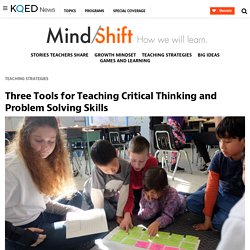
While many teachers agree with this premise, they don’t often know exactly how to teach these skills explicitly, especially because many of the mandates and required curriculum seem to push in the opposite direction. Process-oriented skills are hard to pin down; teachers can see them in certain students, but developing these competencies in students who aren’t already demonstrating them can be tricky.
A few teachers in Ontario, Canada have been experimenting with tools they think could make the difference. “I wanted the kids to realize there is no bad answer,” Watt said. Critical Thinking in the 21st Century and Beyond. The Best Critical Thinking Definitions We've Seen on the Web. What is critical thinking?
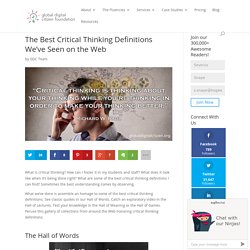
How can I foster it in my students and staff? What does it look like when it’s being done right? What are some of the best critical thinking definitions I can find? Sometimes the best understanding comes by observing. 10 Great Critical Thinking Activities That Engage Your Students. 10 Great Critical Thinking Activities That Enga... Gone Home: A Video Game as a Tool for Teaching Critical Thinking Skills. By Matthew Farber Educators are held responsible for several aspects of English-language arts competency with their students: critical thinking, writing, assessing narrative structures, thinking about how characters develop and how setting affects character.
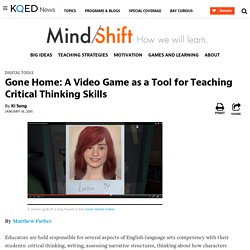
Teachers have a variety of vehicles for conveying those lessons, but a new tool has emerged for learning with digital games. Books have a linear format; films have an arc; art has a focal point; stanzas in a poem are read in order. But a recently published game called “Gone Home” is testing the traditional progression of learning by flattening the story. Players have questioned whether it qualifies as a game since it doesn’t include traditional points, prizes and leveling up (the game is self-titled as “a story exploration video game”).
Gone Home: A Video Game as a Tool for Teaching Critical Thinking Skills. Critical thinking for the 21st century. Critical Thinking Model 1. To Analyze Thinking We Must Identify and Question its Elemental Structures Standard: Clarityunderstandable, the meaning can be grasped Could you elaborate further?
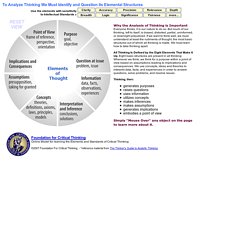
Could you give me an example? Could you illustrate what you mean? Standard: Accuracyfree from errors or distortions, true. 6 Steps to Help Students Find Order in Their Thinking. Like magic, the fish turn into birds and then back into fish. M.C. Escher's tessellations have a way of grabbing your attention and forcing your mind to make sense of the impossible figures on the paper. The Merriam dictionary describes tessellations as, "a covering of an infinite geometric plane without gaps or overlaps by congruent plane figures of one type or a few types. " A geometry book I have on hand describes tessellations as geometric forms that make use of all available foreground and background space in two dimensions by repeating one or more different shapes in predictable patterns.
To tessellate a single shape it must be able to exactly surround a point, or in other words, the sum of the angles around each point in a tessellation must be 360. Using the six steps listed below, tessellated thinking might be a way to help students make order out of the mental chaos our young learners often experience: Why Reading On A Screen Is Bad For Critical Thinking "Think fast! " As kids, that's what we used to say at school recess when tossing the ball around. Is "Think fast! " what we're now saying when we read? Historically, thinking and reading have gone hand-in-hand. Using Film to Teach Analysis Skills. Growing up, my family's Sunday night ritual was always the single word, dinner-and-a-movie.
We were passionate about cinema, and a post-movie debate was always included in the evening's entertainment. In fact, one of the most memorable fights with my dad was over his inability to delay his analysis of Hoosiers before the end credits had even rolled. Needless to say, it wasn't just the movies themselves that became like a different food group to me; it was the enthusiastic post-movie analysis that also gave me sustenance. During these talks, my sister and I brought in our prior knowledge from other books, from other movies, and from what few experiences we already had.
Movie Criticism in the Classroom For this reason, as a teacher, I now leverage movie criticism into my classroom as a means to bring real-world authenticity to my literacy analysis unit. 1. 2. When you analyze an art form, like theater, music, books, or movies, you are actually acting as a critic of sorts. 3. Computational thinking boosts students’ higher-order skills. Technology has certainly made many tasks easier and more efficient. What once took hours or even months — capturing and analyzing data, typing documents, searching for information, and sending messages around the world, for instance — we can now accomplish in a fraction of the time with help from our digital tools.
Taking these lower-order undertakings off our plates has changed our lives in many ways. But perhaps an even more important consequence of the digital age is its impact on our higher-order thinking. Resources and Downloads for Teaching Critical Thinking. Tips for downloading: Teaching Metacognition: Insight Into How Your Students Think Is Key To High Achievement In All Domains.
Report Finds ‘Deeper Learning’ Model Improves Outcomes for All Students. The conversation about what kids need to know and to be able to do by the end of high school has gradually shifted over the past several years to emphasize not just rigorous content goals, but also less tangible skills, such as creative thinking, problem-solving and collaboration. That shift has brought schools that are practicing “deeper learning” into focus.
The William and Flora Hewlett Foundation has been a big supporter of this work, defining deeper learning as a model that focuses on critical thinking, communication, collaboration, academic mindsets and learning how to learn, all through rigorous content. New research conducted by the American Institutes for Research (AIR) has found that the deeper learning model does have positive learning outcomes for students, regardless of their background. The model is often critiqued as a framework that only works for high-achieving learners. The Power of "I Don't Know" The role of teaching has evolved. No longer are we the carriers of knowledge, giving it to students and assessing if they can repeat facts successfully.
We are, instead, tasked with teaching students how to find answers themselves. Using Webb's Depth of Knowledge to Increase Rigor. The word "rigor" is hard to avoid today, and it provokes strong reactions from educators. Using Webb's Depth of Knowledge to Increase Rigor. Let's Stop Trying To Teach Students Critical Thinking. Ah, but you lost the point I was making: Languages and literature give you the sound basis for understanding society and culture. But it doesn't necessarily teach critical thinking, because the available books to do reports on are often limited, and the interpretation of those book reports are done by teachers who do not use critical thought as a basis for their grading of the content. Critical Thinking Pathways. Teaching Critical Thinking in Age of Digital Credulity. The Importance Of Critical Thinking. Source: www.eftbrisbane.com | Original Post Date: January 3, 2009 - Critical Thinking. Two Great Classroom Posters on The Six Thinking Hats.
Interesting Poster Featuring The 7 Tenets of Creative Thinking. 6 Steps to Help Students Find Order in Their Thinking. Resources and Downloads for Teaching Critical Thinking. 7 Tenets of Creative Thinking. In school, we learn about geniuses and their ideas, but how did they get those ideas? What are the mental processes, attitudes, work habits, behaviors, and beliefs that enable creative geniuses to view the same things as the rest of us, yet see something different?
The following are seven principles that I've learned during my lifetime of work in the field of creative thinking -- things that I wish I'd been taught as a student. 1. You Are Creative Artists are not special, but each of us is a special kind of artist who enters the world as a creative and spontaneous thinker. 2. You must show passion and the determination to immerse yourself in the process of developing new and different ideas. 3. The 5 Step Model to Teach Students Critical Thinking Skills.